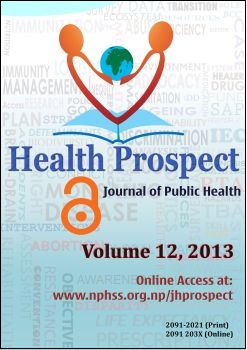Knowledge about Tuberculosis among Drug Users in Kathmandu Valley
DOI:
https://doi.org/10.3126/hprospect.v12i1.8719Keywords:
knowledge, tuberculosis, drug users, risk, educationAbstract
Background Drug use is a significant risk factor for acquiring tuberculosis (TB) infection and progressing to active TB due to high Human Immunodeficiency Virus (HIV) seroprevalence, low socio-economic status, poor environmental conditions and problems of access to health care. Illicit drug users are at high risk for TB.
Objective To assess the knowledge about TB among drug users whereas the specific objectives are to assess the knowledge about how TB is acquired, transmitted and prevented, the signs and symptoms of TB including diagnosis, curability and the source of information.
Methodology Descriptive cross sectional study among 45 male and 18 female drug users in two centers each of Kathmandu and Lalitpur. Semi structured interview schedule was used to collect data. In Depth Interview (IDI) was conducted among 5 drug service providers using IDI guidelines.
Results Majority of users (42%) were between 25-29 years and male (71%). About 13% respondents had family history of drug use. Major source of information was print media. Only 33% respondents had the correct knowledge about the causes of TB; however knowledge regarding signs and symptoms was found to be good. About 64% respondents had correct knowledge regarding transmission and 44% about its diagnosis. About 97% respondents knew that TB can be cured but not about the medications and treatment duration. Most users (71%) were familiar with preventive measures. In-depth Interview with drug service providers revealed that drug users are at high risk of acquiring TB as their knowledge regarding TB was poor and drug users ignored about TB.
Conclusion Although drug users are at high risk for contracting and spreading TB, the level of knowledge about TB was low. It is necessary to provide them with TB related information and education to reduce the burden of TB.
DOI: http://dx.doi.org/10.3126/hprospect.v12i1.8719
Health Prospect: Journal of Public Health Vol.12(1) 2013: 1-6




